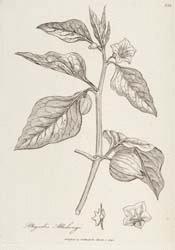
Botanical.com Home Page

|
Strawberry groundcherry
(Prunus avium)
Click on graphic for larger image
|
Cherry, Winter
Botanical: Physalis alkekengi (LINN.)
Family: N.O. Solonacea
---Synonyms---Alkekengi officinale. Coqueret. Judenkirsche. Schlutte. Cape Gooseberry. Strawberry Tomato.
---Parts Used---The fruits and the leaves.
---Habitat---Europe. China and Cochin-China. An escape in the United States.
---Description---The name of Physalis is derived from the Greek phusa (a bladder), for the five-cleft calyx greatly increases in size after the corolla falls off, thus enclosing the fruit in a large, leafy bladder. The plant bears smooth, dark-green leaves and yellowish-white flowers. The fruit is a round, red berry, about the size of a cherry, containing numerous flat seeds, kidney-shaped. It will grow freely in any garden, but sufficient is found growing wild for medicinal purposes.
The leaves and capsules are the most bitter parts of the plant. The epicarp and calyx include a yellow colouring matter which has been used for butter.
The berries are very juicy, with a rather acrid and bitter flavour. In Germany, Spain and Switzerland they are eaten freely, as are other edible fruits. By drying they shrink, and fade to a brownish-red.
---Constituents---Physalin, a yellowish, bitter principle, has been isolated by extracting an infusion of the plant with chloroform. Lithal is sold as an extract of the berries to which lithium salt has been added. The fruit contains citric acid.
---Medicinal Action and Uses---The berries are aperient and diuretic, are employed in gravel, suppression of urine, etc., and are highly recommended in fevers and in gout. Ray stated that a gouty patient had prevented returns of the disorder by taking eight berries at each change of the moon. Dioscorides claimed that they would cure epilepsy. The country people often use them both for their beasts and for themselves, and especially for the after-effects of scarlet fever.
The leaves and stems are used for the malaise that follows malaria, and for weak or anaemic persons they are slightly tonic. A strong dose causes heaviness and constipation, but sometimes they have cured colic followed by diarrhoea.
While not so prompt in its action as sulphate of quinine, the powder is a valuablefebrifuge.
The leaves, boiled in water, are good for soothing poultices and fomentations.
---Dosage---From 6 to 12 berries, or 1/2 an oz. of the expressed juice.
---Other Species---
P. viscosa (Ground Cherry or Yellow Henbane) can be used in a similar manner.
P. somnifera is a narcotic. The leaves are used in India, steeped in warm castoroil, as an application to carbuncles and other inflammatory swellings. The seeds are used to coagulate milk. Kunth states that the leaves have been found with Egyptian mummies.
The plant sold in pots as Winter Cherry is Solanum pseudo-capsicum.
[Top]
Common Name Index
A MODERN HERBAL Home Page
Bear in mind "A Modern Herbal" was written with the conventional wisdom of the early 1900's. This should be taken into account as some of the information may now be considered inaccurate, or not in accordance with modern medicine.
© Copyright Protected 1995-2025 Botanical.com
|

